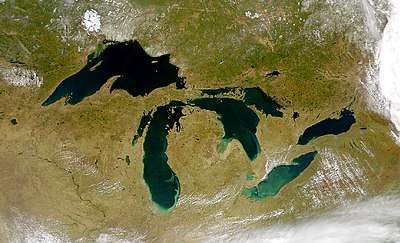Cootes Paradise
Cootes Paradise Marsh is a wetland at the western end of Lake Ontario, on the west side of Hamilton Harbour. It is located in the city of Hamilton, Ontario, Canada. It is owned and managed by Royal Botanical Gardens (RBG), a charitable organization established in 1941 by the Government of Ontario. The marsh is part of the Cootes Paradise Nature Reserve, with these lands representing 99% of the unaltered lands along the local Lake Ontario shoreline. The site is a National Historic Site, a Nationally Important Bird Area (IBA), and an Important Amphibian and Reptile Area (IMPARA). Cootes Paradise is sometimes also called the Dundas Marsh.
History

The marsh was named for Thomas Coote, a British Army officer stationed in the Niagara area during the American Revolutionary War. The association of the marsh with Thomas Coote as a place he would visit to hunt and fish was recorded in the diary of Elizabeth Simcoe, wife of John Graves Simcoe, the first Lieutenant Governor of Upper Canada in 1796. [1]
Originally a seasonally flooded river mouth marsh feed by Spencer Creek, it provided habitat to a wide variety of lifeforms. The habitat went into decline beginning in the late 19th century as a result of water pollution, human overuse, and the introduction of carp into Lake Ontario. A developer settled with the city of Hamilton for owed taxes and the Cootes Paradise wetlands became public property in 1927. It was placed under the control of the Royal Botanical Gardens for management.[2]
By 1985, 85% of its plant cover was lost, 90% of the remainder was non-native species, and the carp population numbered over 70,000 fish. As part of ongoing efforts to reverse this ecological decline, RBG introduced Project Paradise in 1993, part of the Hamilton Harbour Remedial Action Plan. The plan focuses on removing sources of stress to the marsh by focusing attention on inflowing water pollution, minimizing the number of spawning carp, and re-establishing native plants. There are a number of identified anthropogenic stresses that have led to the unbalanced populations of carp and Canada geese. These are water quality and quantity based. Poor water clarity is a result of extremely high nutrient and sediment levels derived from sewage and urban runoff. Rapid sediment accumulation is the result of unmanaged land use patterns in the watersheds, while the regulated water level in Lake Ontario has dramatically altered the flooding pattern. Project Paradise is one of the largest wetland rehabilitation projects in North America.
Controlled burns have also been conducted in an effort to restore some of the old field areas to their original Oak savanna ecosystem, a rare grouping of Carolinian plants and animals. Cootes Paradise Marsh is connected to Hamilton Harbour via the Desjardins Canal, which was dug through the wetland between 1826 and 1837 to connect Dundas, Ontario, with shipping on the Great Lakes. It was later straightened by an excavation through the Burlington Heights in 1851.
In 2000, the City of Hamilton constructed a 3 km recreational trail connecting Royal Botanical Gardens to Pier 4 Park; this trail is also part of the Waterfront Trail system. Royal Botanical Gardens' trails are open to passive recreation only as the area is a National Historic site, Nationally Important Bird Area (IBA), Important Amphibian and Reptile Area (IMPARA), containing numerous endangered species. As such, activities such as biking, jogging and orienteering are against the by-laws other than on the Desjardins Trail.
Birds
Cootes Paradise is designated a nationally Important Bird Area (IBA) due to its strategic location at the tip of Lake Ontario and with the Central and Mississippi Flyways. As a result, hundreds of species of birds use Cootes Paradise at some point during the year, most notably during the spring and autumn migratory periods. Notable species include the least bittern, hooded warbler, white pelican, Caspian tern, black-crowned night-heron, osprey, pileated woodpecker, and the prothonotary warbler. Recently, a nesting pair of bald eagles have recolonized the marsh on the north shore of Cootes Paradise. This is the first such nest on Lake Ontario in more than 40 years.[3]
Fish
The wetlands function as a seasonal fish nursery for Lake Ontario, and despite the historical degradation, most historical species of fish can still be found using the marsh in increasing numbers. As with birds and plants the location is a biodiversity hotspot for Canada with over 60 species present. Each spring thousands of spawning fish migrate in through the fishway from the harbor and lake, laying eggs and leaving shortly after, allowing the marsh to function as a giant fish hatchery. Annually between 5 and 20 million fish are produced for the lake depending on water levels and water pollution events. The species present reflect the degraded marsh habitat with the most common the gizzard shad (formerly carp). Also common are night time predators species channel catfish and brown bullhead, along with invasive species such as alewife and white perch. Popular angling species present in limited numbers include pike, largemouth bass, and yellow perch, but the large adults are only present in the marsh during the spawning season which is closed to fishing. The spring and fall season also brings several migrating salmon and trout to the marshes main inflowing river.
In 2007, when there was low water level in Lake Ontario and a favorable wind, all the water was pushed out of Cootes Paradise and the remaining carp swam out into Hamilton Harbour. RBG staff removed the fish gates and herded out the last of the carp, and then replaced the gates. Since then the wetland has been relatively carp free. In the absence of these large destructive bottom feeders there is a gradual return natural native plant species populations.[4]
Reptiles
Large populations of turtles inhabit Cootes Paradise, including Painted Turtles, Common Snapping Turtles, and Northern Map Turtles. Several species of snakes are also found in the area, including Northern Water Snakes.
Mammals
Over 30 mammal species inhabit Cootes Paradise, including white-tailed deer, red fox, raccoon, beaver, cottontail rabbit, muskrat, mink, opossum, red squirrel, coyote, southern flying squirrel, northern flying squirrel, star-nosed mole, and peculiar species such as the water vole.
Plants
Cootes Paradise is home to the highest concentration of plant species in Canada at over 750 native species; however, an additional 300 have also been introduced following European settlement of the area, putting strain on the local ecosystem's ability to function. Among the trees found in Cootes Paradise are various species of oak, maple, and pine, as well as less common species such as sassafras tree, Kentucky coffee tree, and tulip tree. Examples can be found along the native trees walk across from the nature centre. In recent years there has been a noticeable loss of trees due to ongoing anthropogenic stresses on the RBG property surrounding Cootes Paradise, and in 2005, following the death of a child participating on a nature hike, the RBG was forced to cut down numerous dead and dying trees that posed a public-safety concern, and alter the trail system to ensure some of the sensitive habitat could remain undisturbed by these activities.
A recent analysis of the checklist of all plants growing within the various nature sanctuaries of RBG reveals that these properties are among the richest spots in Canada for plant diversity, with 24% of the flora of Canada and 38% of the flora of Ontario present. Among this diversity are multiple nationally and provincially endangered species.
West of Bull's Point is an island called Hickory Island. The island was dominated by Hickory tree, but was killed by Double-crested cormorant, due to their feces being very toxic. The RBG tried to scare away them a few times with Fireworks, but they still remain on the island.
Southern wild rice, Zizania Aquatica, has been successfully reintroduced by the Royal Botanical Gardens
References
- https://www.archives.gov.on.ca/en/explore/online/simcoe/simcoe-final-years.aspx
- Weinberg, Paul (2017). "Beautiful Cities". Canada's History. 97 (6): 30–37. ISSN 1920-9894.
- "First eaglets born on north shore of Lake Ontario in decades". CBC News. March 25, 2013.
- "thestar.com - The Star - Canada's largest daily". thestar.com. Retrieved 19 April 2018.
External links
| Wikimedia Commons has media related to Cootes Paradise. |
- McGuiness, Eric. May 25, 2005. Fish Paradise [Online]. Hamilton Spectator.
- Royal Botanical Gardens. Project Paradise [Online]. http://www.rbg.ca/projectparadise.
- Smith, T. 2003. Checklist of the spontaneous flora of Royal Botanical Gardens' nature sanctuaries. [Online]. https://web.archive.org/web/20061230094241/http://www.rbg.ca/pdf/RBGChecklist03.pdf
- Toronto Star: Carp leaving Cootes Paradise (December 6, 2007)
